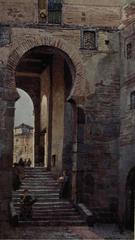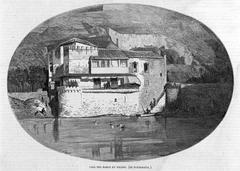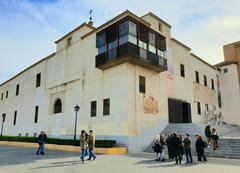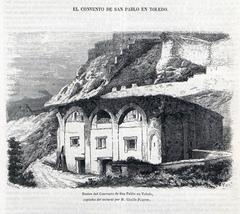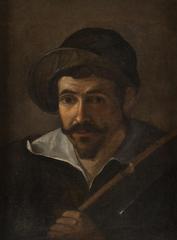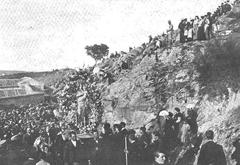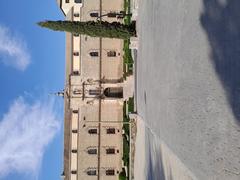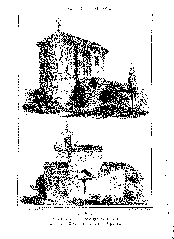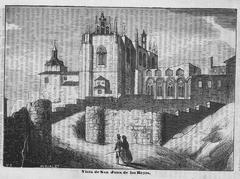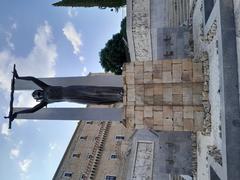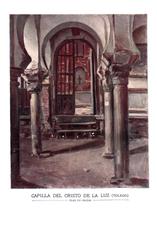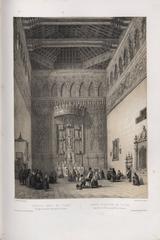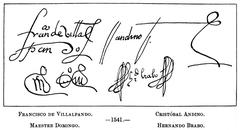
Palacio Arzobispal Toledo: Visiting Hours, Tickets, and Travel Guide
Date: 04/07/2025
Introduction
The Palacio Arzobispal de Toledo (Archbishop’s Palace of Toledo) is a monumental testament to the city’s religious, political, and cultural evolution. Situated in the heart of Toledo, opposite the iconic cathedral, this historic palace has witnessed centuries of ecclesiastical power and artistic innovation. Though its interior is rarely open to the public, its grand façades, rich history, and central location make it an essential stop for visitors exploring Toledo’s architectural and spiritual heritage (cultura.castillalamancha.es).
This guide offers a detailed overview of the palace’s history, architectural highlights, cultural significance, and practical visitor information, including opening hours, ticketing, accessibility, and tips for a memorable visit.
Historical Overview
Origins and Development
The Palacio Arzobispal originated in the 13th century, when King Alfonso VIII donated a set of houses to Archbishop Rodrigo Jiménez de Rada, laying the foundation for what would become one of Toledo’s most significant complexes (cultura.castillalamancha.es). Over successive centuries, archbishops expanded the palace, acquiring adjacent properties and adapting the ensemble to evolving needs.
Architectural Evolution
- Medieval Growth: The palace began as a collection of houses, gradually unified through the efforts of various archbishops. By the late Middle Ages, it covered an entire city block.
- Renaissance Transformation: In the 16th century, Cardinal Juan Pardo de Tavera commissioned Alonso de Covarrubias to redesign the main façade and connect the palace to the cathedral with an archway, introducing classical Renaissance elements (wikipedia).
- Baroque and Neoclassical Enhancements: The 17th and 18th centuries brought unification of the façades and the construction of new elements under Cardinal Lorenzana, adding Baroque and neoclassical touches (cultura.castillalamancha.es).
Stylistic Highlights
The palace’s architecture is a remarkable blend of Mudéjar, Gothic, Renaissance, Baroque, and Neoclassical styles. Notable features include a Mudéjar patio with intricate brickwork, a Renaissance portal with Ionic columns, and heraldic sculptures that reflect the prestige of its ecclesiastical patrons (abrasador.com).
Architectural Features
Main Facade (Plaza del Ayuntamiento)
Facing the Plaza del Ayuntamiento, the principal façade—designed by Covarrubias—features a grand semicircular granite arch, flanked by Ionic columns and topped by a Doric frieze. Above, sculpted nymphs bear the cardinal’s coat of arms, and a prominent balcony with ironwork and a glass cross crowns the entrance (es.wikipedia).
Eastern and Northern Facades
The eastern façade, remodeled in the late 18th century, exhibits symmetry and balanced proportions, with rusticated pilasters and three levels of windows and balconies. The northern façade, giving access to the palace chapel, is distinguished by a semicircular arch with classical decoration and a niche housing a statue of the Immaculate Conception (es.wikipedia).
Interior and Courtyards
The palace’s interior, generally closed to visitors, consists of interconnected rooms, galleries, and courtyards. The main entrance leads to a vaulted gallery and a central courtyard, combining stone and brick construction for both strength and elegance (es.wikipedia).
Cultural and Religious Significance
Episcopal Power and Christian Heritage
As the official residence of the archbishops of Toledo—historically the Primate of Spain—the palace was a focal point for ecclesiastical authority. It hosted synods, councils, and major church decisions, reinforcing Toledo’s central role in Spanish Catholicism (Turismo Alcalá).
Royal Connections and Historical Events
The palace’s history is intertwined with Spanish royalty, having hosted monarchs such as Ferdinand and Isabella and serving as the venue for Columbus’ first audience with the Catholic Monarchs—a pivotal moment in world history (Turismo Alcalá).
Artistic and Educational Legacy
The palace’s halls have been the site of important religious and intellectual gatherings. Its collection of artworks, tapestries, and religious artifacts reflects the changing tastes and devotional practices of Toledo’s elite (Turismo Alcalá).
Architectural Syncretism and Interfaith Resonance
The varied styles of the palace, particularly its Mudéjar elements, reflect Toledo’s broader identity as the “City of Three Cultures,” where Christian, Muslim, and Jewish traditions have historically coexisted (Living Nomads).
Visiting Information
Location and Access
The Palacio Arzobispal is centrally located at Plaza del Ayuntamiento, directly opposite the cathedral. The area is pedestrian-friendly and easily reached on foot from major city landmarks and parking areas. Public transportation, including buses to Zocodover Square, brings visitors within a short walk of the site (Catedral de Toledo).
Accessibility
The plaza and palace exterior are accessible to most visitors, though the cobblestone streets and inclines may present challenges for those with limited mobility. Interior access, when available, may be limited due to stairs and the building’s historic structure.
Visiting Hours
- Regular Access: The interior of the Palacio Arzobispal is not open for daily public visits. Entry is usually restricted to special events, cultural programs, or guided tours.
- Exterior Viewing: The façade and plaza can be enjoyed at any time, with evening illumination providing a striking view.
- Special Openings: Check the Catedral de Toledo website or the Toledo Tourist Office for updates on special openings or events.
Tickets
There is no standard ticketing for the palace. When special tours or events are held, tickets may be required and are typically available through official tourism channels. Pricing varies by event.
Guided Tours
Occasional tours are offered, providing access to areas typically closed to the public and in-depth commentary from expert guides. Early booking is recommended due to limited availability.
Amenities
There are no visitor facilities within the palace, but cafés, restaurants, and public restrooms are available nearby. The Toledo Tourist Office offers maps, assistance, and up-to-date information.
Nearby Attractions
- Toledo Cathedral: A masterpiece of Gothic architecture directly opposite the palace (Catedral de Toledo).
- Iglesia del Salvador: A former mosque, now a church with layers of history.
- Iglesia de Santo Tomé: Home to El Greco’s famous painting.
- Sinagoga del Tránsito and Sinagoga de Santa María la Blanca: Important sites in Toledo’s Jewish heritage (Asturnatura).
- Puente de Alcántara and Puerta de Bisagra: Historic gates and bridges framing the city’s core.
Practical Tips for Visitors
- Plan Ahead: Monitor official sources for possible openings, tours, or events.
- Arrive Early: Enjoy the plaza and photograph the palace with fewer crowds.
- Combine Your Visit: Pair the palace with the cathedral and other nearby sites.
- Dress Comfortably: Wear appropriate footwear for uneven streets.
- Respect the Setting: The palace is an active ecclesiastical site; maintain respectful behavior and attire.
Frequently Asked Questions (FAQ)
Can I visit the interior of the Palacio Arzobispal?
Regular interior access is not available; entry is possible only during special events or guided tours.
Where can I purchase tickets for special events or tours?
Tickets, when required, are available via the Catedral de Toledo website or at the Toledo Tourist Office.
Is the palace accessible for those with mobility challenges?
The exterior and plaza are accessible, but interior access is limited; inquire in advance for specific accommodations.
Is photography allowed?
Photography is permitted for the exterior. Policies for interior photography depend on the event or tour.
What other historical sites are nearby?
The palace is close to the cathedral, Iglesia del Salvador, Iglesia de Santo Tomé, and the city’s main synagogues.
Visual and Media Suggestions
- Feature high-quality images of the palace façade, grand staircase, and illuminated views at night.
- Use descriptive alt tags, such as “Palacio Arzobispal illuminated at night” and “Grand staircase entrance.”
- Embed an interactive map highlighting nearby attractions and walking routes within Toledo’s old town.
Summary and Recommendations
The Palacio Arzobispal de Toledo is an essential landmark for understanding the city’s layered history, religious authority, and architectural diversity. Its rich blend of styles embodies Toledo’s identity as the “City of Three Cultures,” and its proximity to major sites makes it a highlight of any visit. Although interior access is generally restricted, the palace’s grand exterior and central location offer a rewarding experience. Enhance your visit by combining it with other notable sites and staying updated on special events through official channels (catedraldetoledo.es). For personalized itineraries and audio guides, consider using travel apps like Audiala.
Sources and Further Reading
- Palacio Arzobispal de Toledo (cultura.castillalamancha.es)
- Archbishop’s Palace of Toledo (Wikipedia)
- Palacio Arzobispal de Toledo (toledoguiaturisticaycultural.com)
- Archiepiscopal Palace (Turismo Alcalá)
- Archbishop’s Palace of Toledo (trek.zone)
- Palacio Arzobispal de Toledo (Catedral de Toledo)
- Toledo Travel Guide (Living Nomads)
- Palacio Arzobispal de Toledo (Abrasador)




